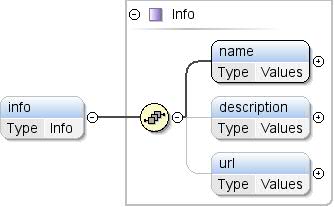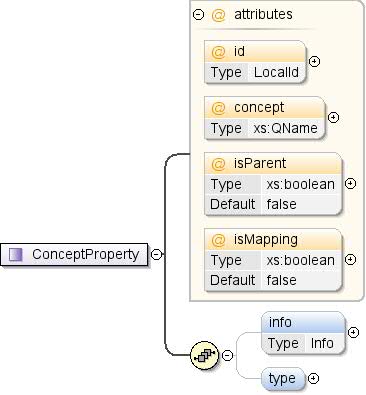Componente: ConceptProperty
Mantieni tutto organizzato con le raccolte
Salva e classifica i contenuti in base alle tue preferenze.
| Spazio dei nomi |
http://schemas.google.com/dspl/2010 |
| Annotazioni |
Informazioni testuali sulla proprietà concettuale. |
| Diagramma |
 |
| Tipo |
Informazioni |
| Proprietà |
| contenuti: |
complesso |
| minOccurs: |
0 |
|
| Modello |
name , description{0,1} , url{0,1} |
| Bambini |
descrizione, nome, url |
| Istanza |
<info>
<name>{1,1}</name>
<description>{0,1}</description>
<url>{0,1}</url>
</info>
|
| Origine |
<xs:element name="info" type="Info" minOccurs="0">
<xs:annotation>
<xs:documentation>Textual information about the concept property.</xs:documentation>
</xs:annotation>
</xs:element>
|
| Spazio dei nomi |
http://schemas.google.com/dspl/2010 |
| Annotazioni |
Il tipo di dati della proprietà concettuale. |
| Diagramma |
 |
| Proprietà |
| contenuti: |
complesso |
| minOccurs: |
0 |
|
| Attributi |
| QName |
Tipo |
Risolto |
Predefinito |
Usa |
Annotazione |
| rif |
DataType |
|
|
di provisioning. |
|
|
| Origine |
<xs:element name="type" minOccurs="0">
<xs:annotation>
<xs:documentation>The data type of the concept property.</xs:documentation>
</xs:annotation>
<xs:complexType>
<xs:attribute name="ref" type="DataType" use="required"/>
</xs:complexType>
</xs:element>
|
Tipo complesso: ConceptProperty
| Spazio dei nomi |
http://schemas.google.com/dspl/2010 |
| Annotazioni |
Una proprietà di un concetto (ad es. il paese di una
città). |
| Diagramma |
 |
| Usato da |
|
| Modello |
informazioni{0,1} , tipo{0,1} |
| Bambini |
informazioni, tipo |
| Attributi |
| QName |
Tipo |
Risolto |
Predefinito |
Usa |
Annotazione |
| concetto |
xs:QName |
|
|
facoltativo |
Un riferimento a un concetto che corrisponde ai valori
della proprietà. Se la proprietà specifica un tipo,
deve corrispondere al tipo del concetto a cui viene fatto riferimento. Un riferimento a un
il concetto esterno deve avere il formato
"prefix:other_concept_id", dove "prefisso" sono
il prefisso utilizzato per lo spazio dei nomi del set di dati esterno (vedi XML
spazi dei nomi). |
| id |
LocalId |
|
|
facoltativo |
L'ID della proprietà concettuale. Questo identificatore deve essere
univoci all'interno del concetto (tra attributi e proprietà). La
ID può essere omesso se viene specificata la proprietà concettuale. In questo
case, un ID viene creato implicitamente con il valore il nome locale
concetto a cui viene fatto riferimento. Ad esempio <property
concept="geo:country"/> equivale a <property
id="country"
concept="geo:country"/> |
| isMapping |
xs:boolean |
|
falso |
facoltativo |
Se true, questa proprietà deve fare riferimento a un concetto e
questa proprietà indica una relazione di mappatura (1:1) tra
concetto e al concetto a cui viene fatto riferimento. Ogni istanza del modello
fa riferimento al massimo a un'istanza di questo
concetto. |
| isParent |
xs:boolean |
|
falso |
facoltativo |
Se true, questa proprietà deve fare riferimento a un concetto e
questa proprietà denota una relazione gerarchica
concetto e al concetto a cui viene fatto riferimento (ad es. il continente di un
paese). |
|
| Origine |
<xs:complexType name="ConceptProperty">
<xs:annotation>
<xs:documentation>A property of a concept (e.g., the country of a city).</xs:documentation>
</xs:annotation>
<xs:sequence>
<xs:element name="info" type="Info" minOccurs="0">
<xs:annotation>
<xs:documentation>Textual information about the concept property.</xs:documentation>
</xs:annotation>
</xs:element>
<xs:element name="type" minOccurs="0">
<xs:annotation>
<xs:documentation>The data type of the concept property.</xs:documentation>
</xs:annotation>
<xs:complexType>
<xs:attribute name="ref" type="DataType" use="required"/>
</xs:complexType>
</xs:element>
</xs:sequence>
<xs:attribute name="id" type="LocalId" use="optional">
<xs:annotation>
<xs:documentation>The id of the concept property. This identifier must be unique within the concept
(across attributes and properties).
The id may be omitted if the concept property is specified. In that case, an id is
implicitly created with value the local name of the referenced concept. For instance
<property concept="geo:country"/>
is equivalent to
<property id="country" concept="geo:country"/></xs:documentation>
</xs:annotation>
</xs:attribute>
<xs:attribute name="concept" type="xs:QName" use="optional">
<xs:annotation>
<xs:documentation>A reference to a concept that corresponds to the values of the property.
If the property specifies a type, then the type must match the type of the
referenced concept.
A reference to an external concept must be of the form "prefix:other_concept_id",
where "prefix" is the prefix used for the namespace of the external dataset
(see XML namespaces).</xs:documentation>
</xs:annotation>
</xs:attribute>
<xs:attribute name="isParent" type="xs:boolean" use="optional" default="false">
<xs:annotation>
<xs:documentation>If true, then this property must reference a
concept, and this property denotes a hierarchical
relationship between this concept and the referenced
concept (e.g., the continent of a country).</xs:documentation>
</xs:annotation>
</xs:attribute>
<xs:attribute name="isMapping" type="xs:boolean" use="optional" default="false">
<xs:annotation>
<xs:documentation>If true, then this property must reference a
concept, and this property denotes a mapping
(1-to-1) relationship between this concept and the
referenced concept. Each instance of the referenced
concept is referenced by at most one instance of
this concept.</xs:documentation>
</xs:annotation>
</xs:attribute>
</xs:complexType>
|
| Spazio dei nomi |
Nessuno spazio dei nomi |
| Tipo |
DataType |
| Proprietà |
|
| Facet |
| enumerazione |
stringa |
|
| enumerazione |
numero in virgola mobile |
|
| enumerazione |
integer |
|
| enumerazione |
booleano |
|
| enumerazione |
data |
|
| enumerazione |
concetto |
|
|
| Usato da |
|
| Origine |
<xs:attribute name="ref" type="DataType" use="required"/>
|
| Spazio dei nomi |
Nessuno spazio dei nomi |
| Annotazioni |
L'ID della proprietà concettuale. Questo identificatore deve essere univoco
all'interno del concetto (tra attributi e proprietà). L'ID può essere
omesso se la proprietà concettuale è specificata. In questo caso, un ID è
creati implicitamente con il valore del nome locale del concetto a cui viene fatto riferimento.
Ad esempio <property concept="geo:country"/> sono
equivalente a <property id="country"
concept="geo:country"/> |
| Tipo |
LocalId |
| Proprietà |
|
| Facet |
|
| Usato da |
|
| Origine |
<xs:attribute name="id" type="LocalId" use="optional">
<xs:annotation>
<xs:documentation>The id of the concept property. This identifier must be unique within the concept
(across attributes and properties).
The id may be omitted if the concept property is specified. In that case, an id is
implicitly created with value the local name of the referenced concept. For instance
<property concept="geo:country"/>
is equivalent to
<property id="country" concept="geo:country"/></xs:documentation>
</xs:annotation>
</xs:attribute>
|
| Spazio dei nomi |
Nessuno spazio dei nomi |
| Annotazioni |
Un riferimento a un concetto che corrisponde ai valori del parametro
proprietà. Se la proprietà specifica un tipo, questo deve corrispondere alla
tipo del concetto a cui viene fatto riferimento. Il riferimento a un concetto esterno deve
avere la forma "prefix:other_concept_id", dove
"prefisso" è il prefisso utilizzato per lo spazio dei nomi dell'agente
(vedi gli spazi dei nomi XML). |
| Tipo |
xs:QName |
| Proprietà |
|
| Usato da |
|
| Origine |
<xs:attribute name="concept" type="xs:QName" use="optional">
<xs:annotation>
<xs:documentation>A reference to a concept that corresponds to the values of the property.
If the property specifies a type, then the type must match the type of the
referenced concept.
A reference to an external concept must be of the form "prefix:other_concept_id",
where "prefix" is the prefix used for the namespace of the external dataset
(see XML namespaces).</xs:documentation>
</xs:annotation>
</xs:attribute>
|
| Spazio dei nomi |
Nessuno spazio dei nomi |
| Annotazioni |
Se true, la proprietà deve fare riferimento a un concetto e questo
denota una relazione gerarchica tra questo concetto e
concetto a cui si fa riferimento (ad es. il continente di un paese). |
| Tipo |
xs:boolean |
| Proprietà |
| usa: |
facoltativo |
| valore predefinito: |
falso |
|
| Usato da |
|
| Origine |
<xs:attribute name="isParent" type="xs:boolean" use="optional" default="false">
<xs:annotation>
<xs:documentation>If true, then this property must reference a
concept, and this property denotes a hierarchical
relationship between this concept and the referenced
concept (e.g., the continent of a country).</xs:documentation>
</xs:annotation>
</xs:attribute>
|
| Spazio dei nomi |
Nessuno spazio dei nomi |
| Annotazioni |
Se true, la proprietà deve fare riferimento a un concetto e questo
denota una relazione di mappatura (1:1) tra questo concetto e
al concetto a cui viene fatto riferimento. Ogni istanza del concetto a cui viene fatto riferimento
a cui si fa riferimento al massimo a un'istanza di questo concetto. |
| Tipo |
xs:boolean |
| Proprietà |
| usa: |
facoltativo |
| valore predefinito: |
falso |
|
| Usato da |
|
| Origine |
<xs:attribute name="isMapping" type="xs:boolean" use="optional" default="false">
<xs:annotation>
<xs:documentation>If true, then this property must reference a
concept, and this property denotes a mapping
(1-to-1) relationship between this concept and the
referenced concept. Each instance of the referenced
concept is referenced by at most one instance of
this concept.</xs:documentation>
</xs:annotation>
</xs:attribute>
|
Creato con
Editor XML ossigeno.
Salvo quando diversamente specificato, i contenuti di questa pagina sono concessi in base alla licenza Creative Commons Attribution 4.0, mentre gli esempi di codice sono concessi in base alla licenza Apache 2.0. Per ulteriori dettagli, consulta le norme del sito di Google Developers. Java è un marchio registrato di Oracle e/o delle sue consociate.
Ultimo aggiornamento 2025-07-25 UTC.
[[["Facile da capire","easyToUnderstand","thumb-up"],["Il problema è stato risolto","solvedMyProblem","thumb-up"],["Altra","otherUp","thumb-up"]],[["Mancano le informazioni di cui ho bisogno","missingTheInformationINeed","thumb-down"],["Troppo complicato/troppi passaggi","tooComplicatedTooManySteps","thumb-down"],["Obsoleti","outOfDate","thumb-down"],["Problema di traduzione","translationIssue","thumb-down"],["Problema relativo a esempi/codice","samplesCodeIssue","thumb-down"],["Altra","otherDown","thumb-down"]],["Ultimo aggiornamento 2025-07-25 UTC."],[],["ConceptProperty defines a characteristic of a concept, with optional `info` and `type`. The `info` contains text about the property, including `name`, `description`, and `url`. `type` specifies the data type. Attributes include an optional `id` for unique identification, an optional `concept` to reference related concepts, `isParent` (hierarchical relationship), and `isMapping` (1-to-1 relationship), both booleans, defaulting to `false`. The `@ref` attribute is required for type and defines the data type of the referenced concept.\n"]]



